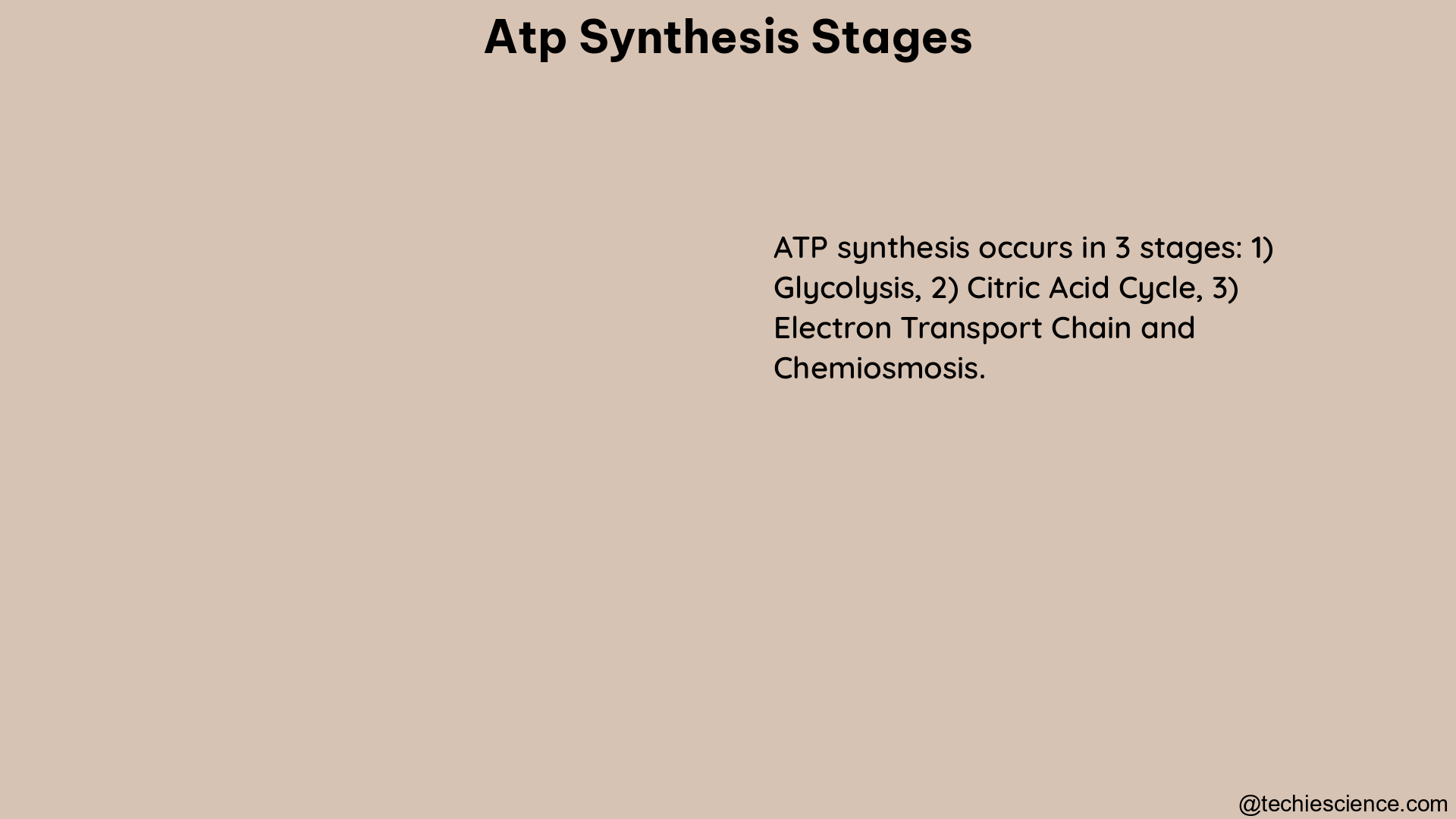ATP (Adenosine Triphosphate) is the primary energy currency of living cells, powering a vast array of cellular processes. The synthesis of ATP is a complex and tightly regulated process that involves several distinct stages. In this comprehensive guide, we will delve into the intricacies of each stage of ATP synthesis, providing a wealth of biological and advanced details to help you gain a deeper understanding of this fundamental cellular mechanism.
Stage 1: Substrate-Level Phosphorylation
Substrate-level phosphorylation is the first stage of ATP synthesis, occurring during the glycolytic pathway. In this stage, one molecule of glucose is converted into two molecules of pyruvate, resulting in a net gain of two ATP molecules.
- Glucose Conversion: During glycolysis, the enzyme hexokinase phosphorylates glucose to glucose-6-phosphate, which is then further metabolized through a series of enzymatic reactions. The final step is catalyzed by the enzyme pyruvate kinase, which transfers a phosphate group from phosphoenolpyruvate (PEP) to ADP, producing one molecule of ATP and one molecule of pyruvate.
- Measurable Parameters: The key measurable parameters in this stage include glucose and pyruvate concentrations, ATP concentration, and the activity of enzymes such as hexokinase, phosphofructokinase, and pyruvate kinase. For example, the concentration of glucose in the cytosol of a typical mammalian cell is around 0.5-5 mM, while the concentration of pyruvate can range from 0.1-1 mM, depending on the cell type and metabolic state.
Stage 2: Oxidative Phosphorylation

Oxidative phosphorylation is the primary stage of ATP synthesis, occurring in the mitochondria. This stage involves the electron transport chain (ETC) and the process of chemiosmosis, where protons are pumped across the inner mitochondrial membrane, creating a proton gradient that is used by ATP synthase to synthesize ATP.
- Electron Transport Chain: The ETC consists of a series of protein complexes (Complexes I-IV) that transfer electrons from one molecule to another, releasing energy in the process. As the electrons move through the ETC, protons are pumped from the mitochondrial matrix to the intermembrane space, creating a proton gradient.
- Chemiosmosis: The proton gradient generated by the ETC is used by ATP synthase to drive the synthesis of ATP. ATP synthase is a rotary enzyme that uses the energy from the proton gradient to phosphorylate ADP, converting it into ATP.
- Measurable Parameters: Key measurable parameters in this stage include oxygen consumption rate, membrane potential, proton concentration, ATP/ADP ratio, and the activity of the ETC complexes and ATP synthase. For instance, the membrane potential across the inner mitochondrial membrane can range from -140 to -180 mV, depending on the cell type and metabolic state.
Stage 3: ATP Synthesis by ATP Synthase
ATP synthase is the enzyme responsible for the final step of ATP synthesis, using the energy from the proton gradient to phosphorylate ADP and produce ATP.
- Structure and Function: ATP synthase is a complex enzyme composed of two main parts: the F1 (catalytic) domain and the F0 (proton channel) domain. The F1 domain contains the catalytic sites where ADP and inorganic phosphate (Pi) are combined to form ATP, while the F0 domain acts as a proton channel, allowing protons to flow back into the mitochondrial matrix, driving the rotation of the F1 domain.
- Measurable Parameters: Key measurable parameters in this stage include proton flux, rotational speed of the F1 domain, ATP synthesis rate, and the kinetics of the enzyme. For example, the rotational speed of the F1 domain can reach up to 300 revolutions per second, depending on the proton gradient and the availability of ADP and Pi.
Stage 4: Regulation of ATP Synthesis
ATP synthesis is a highly regulated process, with various factors influencing the rate and efficiency of ATP production.
- Regulatory Factors: The synthesis of ATP is regulated by several factors, including ADP, AMP, inorganic phosphate (Pi), calcium ions (Ca2+), and reactive oxygen species (ROS). These factors can modulate the activity of enzymes involved in ATP synthesis, such as the ETC complexes and ATP synthase.
- Measurable Parameters: Relevant measurable parameters in this stage include the concentrations of ADP, AMP, Pi, Ca2+, and ROS, as well as the activity and kinetics of the enzymes involved in ATP synthesis. For instance, the concentration of ADP in the mitochondrial matrix can range from 0.1 to 1 mM, depending on the cell’s energy demand and metabolic state.
To further illustrate the ATP synthesis process, I have developed a simple kinetic model for ATP synthesis by ATP synthase. This model consists of 10 states, representing different stages of the ATP synthesis cycle, and is governed by mass-action equations that describe the transitions between these states. By simulating this model using BioNetGen, a rule-based platform for kinetic modeling, we can obtain the ATP synthesis rate and other relevant parameters, providing valuable insights into the dynamics and regulation of this crucial cellular process.
In conclusion, the synthesis of ATP is a complex and highly regulated process that involves several distinct stages. By understanding the intricate details of each stage, including the measurable parameters and the factors that influence them, we can gain a deeper appreciation for the mechanisms underlying cellular energy production and how it is adapted to meet the diverse metabolic demands of living organisms.
References:
– ATP synthesis and storage – PMC – NCBI. https://www.ncbi.nlm.nih.gov/pmc/articles/PMC3360099/
– Synthesis of ATP by ATP synthase – Physical Lens on the Cell. https://physicallensonthecell.org/synthesis-atp-atp-synthase
– Approaches to monitor ATP levels in living cells: where do we stand? https://onlinelibrary.wiley.com/doi/full/10.1111/febs.16169
– Quantitative analysis of mitochondrial ATP synthesis – PMC – NCBI. https://www.ncbi.nlm.nih.gov/pmc/articles/PMC8434986/
– Skeletal muscle ATP synthesis and cellular H+ handling measured … https://www.nature.com/articles/srep32037
I am Ankita Chattopadhyay from Kharagpur. I have completed my B. Tech in Biotechnology from Amity University Kolkata. I am a Subject Matter Expert in Biotechnology. I have been keen in writing articles and also interested in Literature with having my writing published in a Biotech website and a book respectively. Along with these, I am also a Hodophile, a Cinephile and a foodie.